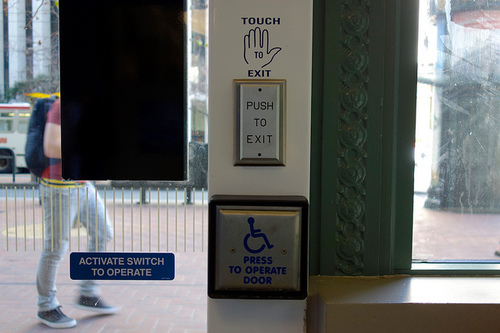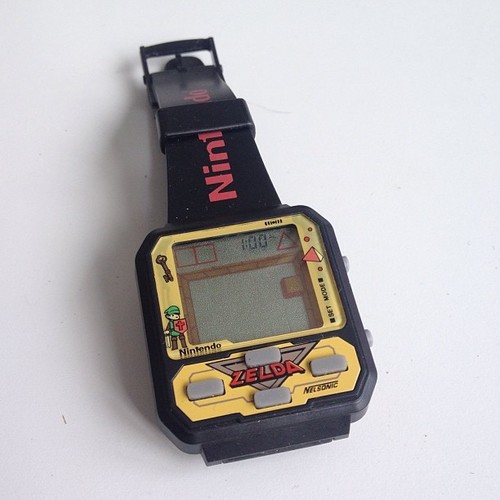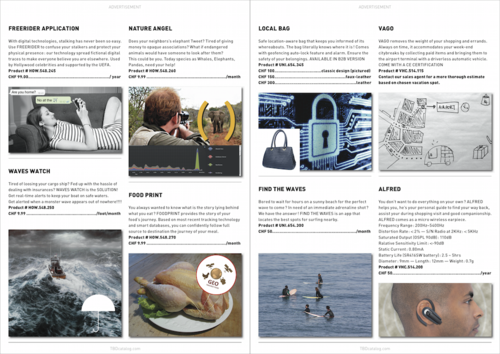
San Francisco, Feb. 2015
"Activate switch", "Touch to Exit", "Push to Exit", "Press to operate door": the vocabulary of doors is impressive here.

The "Legend of Zelda" watch is a multi-purpose device made by Nelsonic Industries, who obtained the Nintendo license back at the end of the 1980s. According to the Wikipedia, 12 million copies were sold, which is quite impressive and perhaps better than recent watch computers.
Is that a smartwatch? That's maybe not the main point here, but it's intriguing to think about the fact that there's already a lot of examples (like this) of showing how computation can help triggering a playful user experience on a wrist-based tiny device.
Beyond the functionalities, I'm also curious of the gestural behavior of the user here. The manipulation of the buttons is tricky but doable, although it's way different than the NES version of Zelda.
WORLD BRAIN by Stéphane Degoutin and Gwenola Wagon:
World Brain proposes a stroll through motley folkloric tales : data centers, animal magnetism, the Internet as a myth, the inner lives of rats, how to gather a network of researchers in the forest, how to survive in the wild using Wikipedia, how to connect cats and stones… The world we live in often resembles a Borgesian story. Indeed, if one wanted to write a sequel to Borges’ Fictions, he could do it simply by putting together press articles. The World Brain is made out mostly of found materials : videos downloaded on Youtube, images, scientific or pseudo scientific reports, news feeds… The project describes the planetary network surrounding us and offers theoretical tools to interpret it. It considers the perverse effects of the universal connection, and the risk for the individuals to become numb, under the reign of collective intelligence. Its goal is to build an alternative project for the survival of mankind. [...] World Brain takes the viewer through a journey inside the physical places by which the Internet transits: submarine cables, data centers, satellites. The film adopts the point of view of the data. The audience view the world as if they were information, crossing the planet in an instant, copied in an infinite number of instances or, at the contrary, stored in secret places.
Why do I blog this? This film nicely complements Timo Arnall's contemplative movie "Internet Machine". This is obviously interesting wrt to a project I'm working on related to cloud computing.
Last week, Julian recommended me this book called "Super Sad True Love" by Gary Shteyngart. A long flight over to Fog City CA gave me plenty of time to peruse it carefully. It's a good novel set in a near future dominated by media, retail/commerce and the collapse of the US economy. It feels a bit like Steak crossed with Idiocracy.
There are many interesting and humorous bits in the book (the critique of media/retail, the transhumanists perspective) but what caught my attention is the way smartphone usage is portrayed. Shteyngart use the term "äppärät" to refer to smartphone/mobile devices. The book offers various descriptions that shed some light on current socio-technological rituals, and upcoming ones:
About the device behavior:
"my äppärät buzzing with contacts, data, pictures, projections, maps, incomes, sound, fury"
"my äppärät began to produce its “heavy thinking” noises, a wheel desperately spinning inside its hard plastic shell, its ancient circuitry completely overtaxed by the otter and his antics. The words ERROR CODE IT/FC-GS/FLAG appeared on the screen"
"I’m learning to worship my new äppärät’s screen, the colorful pulsating mosaic of it, the fact that it knows every last stinking detail about the world, whereas my books only know the minds of their authors."
"My äppärät pinged."
"But even he seemed unimpressed, glancing impatiently at his äppärät, which was alive with at least seven degrees of information, numbers and letters and Images stacked on the screen, flowing and eddying against one another as the waters of the Tiber once did."
On device usage and gesturing practices:
"A half-dozen of my fellow citizens were seated behind their chewed-up desks, mumbling lowly into their äppäräti. There was an earplug lying slug-dead on an empty chair, and a sign reading INSERT EARPLUG IN EAR, PLACE YOUR ÄPPÄRÄT ON DESK, AND DISABLE ALL SECURITY SETTINGS."
"I took out my äppärät, flicked it open in a gesture that was au courant maybe a decade ago, held it stupidly in front of me, put it back in my shirt pocket, then reached for a nearby bottle and refilled my glass."
"my äppärät picked up on some scan-able faces, an old-time porno star and a slick guy from Mumbai just starting out on his first worldwide Retail empire."
"I took out my äppärät and began to thump it loudly with my finger to show how much I loved all things digital, while sneaking nervous glances at the throbbing cavern around me, the wine-dulled business travelers lost to their own electronic lives."
"I took out my äppärät, but noticed that the new kids all had the new pebble-like model around their necks, the kind Eunice had worn."
"I lay in my bed, listening to Eunice teening furiously on her äppärät in the living room."
"her index fingers raised above the book as if ready to tap at the BUY ME NOW symbol on her äppärät,"
"Shu descended into another äppärät reverie. I did the same, pretending it was something serious and work-related, but really I was just GlobalTracing Eunice’s location."
Of course, there's a lot on social rituals, scanning, personal scores (which reminded me of Doctorow's reputation currency called 'whuffie') and surveillance:
"My äppärät data were sampled and scanned to a military äppärät by a young man who seemed to be missing a face beneath his cap’s long green visor."
"he wasn’t there. He didn’t have an äppärät, or it wasn’t set on “social” mode, or maybe he had paid some young Russian kid to have the outbound transmission blocked."
"They trooped past me, surprised, agitated, bemused, their äppäräti already projecting data about me, perhaps telling them how little I meant, my thirty-nine-year-old obsolescence."
"We need to get you a new äppärät,” he said. “You’re going to have to learn to surf the data streams better. Learn to rank people quicker.”
"Shu, a goddamn relentless immigrant in the mode of my janitor father but with English and good board scores on his side, was dealing with three äppäräti at once, his callused fingertips and spitfire Chinatown diction abuzz with data and the strong, dull hope that he was squarely in control."
“Learn how to use this thing immediately,” Shu told me. “Especially the RateMe part. Learn to rate everyone around you. Get your data in order. Switch on CrisisNet and follow all the latest. An ill-informed salesman is dead in the water these days. Get your mind in the right place."
"I put the name of my oldest Media pal, Noah Weinberg, into my äppärät and learned that he would be airing our reunion live on his GlobalTeens stream, “The Noah Weinberg Show!,” which made me nervous at first, but, then, this is exactly the kind of thing I have to get used to if I’m going to make it in this world"
“Damn, cabrón,” Noah said, eyeing my pebble. “Whuddat, a 7.5 with RateMe Plus? I’m going to stream that shit fucking close-up.” He filmed my äppärät with his äppärät, while I swallowed another mug of triglycerides."
“‘FAC? What’s that? Who am I? Where’s my diaper?’” “It means ‘Form A Community,’” Vishnu said. “It’s, like, a way to judge people. And let them judge you.” He took my äppärät, and slid some settings until an icon labeled “FAC” drifted onto the screen. “When you see FAC, you press the EmotePad to your heart, or wherever it can feel your pulse.” Vishnu pointed out the sticky thing on the back of my äppärät that I thought could be used to attach it to a dashboard or a fridge. Wrong again. “Then,” Vishnu continued, “you look at a girl. The EmotePad picks up any change in your blood pressure. That tells her how much you want to do her.”
“Set up your Community Parameters. Make it ‘Immediate Space 360’—that’ll cover the whole bar. Now look at a girl, then press the pad to your heart.” I looked at the pretty brunette, at the hairless crotch glowing from within her see-through Onionskin jeans, at the lithe body crouched imperiously atop a set of smooth legs, at her worried smile. Then I touched my heart with the back of my äppärät, trying to fill it with my warmth, my natural desire for love. The girl across the bar laughed immediately without even turning my way. A bunch of figures appeared on my screen: “FUCKABILITY 780/800, PERSONALITY 800/800, ANAL/ORAL/VAGINAL PREFERENCE 1/3/2.”
“The personality score depends on how ‘extro’ she is,” Vishnu explained. “Check it out. This girl done got three thousand–plus Images, eight hundred streams, and a long multimedia thing on how her father abused her. Your äppärät runs that against the stuff you’ve downloaded about yourself and then it comes up with a score. Like, you’ve dated a lot of abused girls, so it knows you’re into that shit"
"Vishnu worked my äppärät until some RANKINGS came up. He helped me navigate the data. “Out of the seven males in the Community,” he said, gesturing around the bar, “Noah’s the third hottest, I’m the fourth hottest, and Lenny’s the seventh.” “You mean I’m the ugliest guy here?” I ran my fingers through the remnants of my hair. “But you’ve got a decent personality,” Vishnu comforted me, “and you’re second in the whole bar in terms of SUSTAINABILIT¥.”
And finally on attention and disconnection:
"She really listened to me. She paid attention to me. She never even looked at her äppärät while I was speaking to her."
"My äppärät isn’t connecting. I can’t connect. No one’s äppäräti are working anymore. “It’s an NNEMP,” all the thirty something Media wizards hanging out in the lobby of our building are saying with finality. A Nonnuclear Electromagnetic Pulse."
"Eunice had opened up her äppärät and was concentrating on the last shopping page stored in its memory before communications collapsed. I could see she had instinctively opened a LandOLakes Credit Payment stream, but every time she tried to input her account info, she ended up throwing her head back as if stung. “I can’t buy anything,” she said. “Eunice,” I said. “You don’t have to buy anything. Go to bed.
Why do I blog this? I started recently a follow-up project to "Curious Rituals", in which I'm exploring smartphone usage. I'm mostly interested in people's gestural and postural habits with these devices. Shteyngart's writing is spot and offer a fascinated perspective on this topic. The humor and accuracy of his descriptions are impressive and it's fascinated to see how such a novel offer a good ethnographic perspective on mobile technology. The fact that it's set in the near future is also pertinent, as some of the features are just a stretch from existing practices.

Last week at Lift 15, I ran a 2-hours workshop with José Achache from the European Space Agency. The idea was to discuss emerging technologies (geopositioning, telecommunications, image capture from satellite) developed by ESA and look at the near future worlds in which they exist: what kind of experiences would come to pass if the world were to be filled with such technologies? What kinds of services may appear? How would they be sold, to whom? What kinds of objects may be designed for everyday use?
With a group of engineers, entrepreneurs and designers, we created a list of service concepts that we described as catalogue items (we re-used here the same template we had for the TBD catalog project). One can see this as a wrap-up of some of the ideas we generated. Each concept is based on a combination of existing technology and we described them as if they were real product sold with a name, a short description, a reference point, and – of course – a price.
In such a small amount of time, it is definitely tricky to produce things like this. Mostly because: participants do not all know each other, we had different "culture" that need time to adjust to one another, it's hard to go from technological potential to service concepting, etc. But overall, the groups did pretty well and some of the ideas we kept seem quite pertinent and plausible I think.
Thank to all the participants (M. Pache, C. Chalas, E. Ndiaye, B. Kerspern, M. Mollon, C. Brand, G. Castrati, E. Hary, P. Tarbouriech, F. Ronse, P. Kiernan, A. Grant, E. Rosenberg, Y. Akhtman, E. Montanari, G. Reboud, N. Huebner, G. Martin de Mercado, D. Tomassini). Thank Constance Delamadeleine for the graphic design help. Plus, thanks José Achache, ESA, the Lift team and Sylvie Reinhard for this opportunity to collaborate.
Next week I’ll be at Interaction 15 (as will be much of the UX community). Along with my Near Future Laboratory colleagues (Julian and Nicolas), we’ll be running a short design fiction workshop. Our aim is to produce a diegetic prototype in just four hours: a quick start guide for a self-driving vehicle, and I plan to share a little of the process here. Keep checking back for updates.